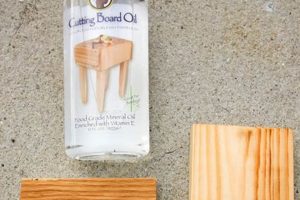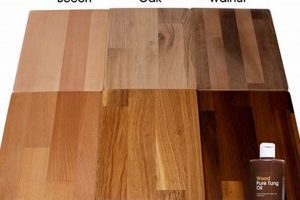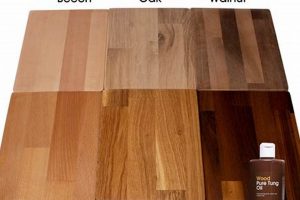Products designed to protect and enhance the aesthetic qualities of surfaces, particularly wood, are a class of coatings widely utilized in woodworking and related crafts. These coatings typically penetrate the surface, providing a durable barrier against moisture, scratches, and other environmental factors. Linseed, tung, and walnut oils are common examples, often chosen for their natural properties and ability to impart a warm, lustrous sheen.
The application of such products is integral to preserving the integrity and extending the lifespan of treated materials. Beyond simple preservation, they can highlight the natural grain and color of wood, adding depth and character. Historically, these types of applications have been used for centuries to protect valuable wooden objects and furniture, reflecting a long-standing recognition of their preservative and aesthetic value.
The following sections will delve into the specific types of these protective coatings, their application techniques, the factors influencing their selection, and best practices for achieving optimal results. A comparative analysis of different formulations and their suitability for various projects will also be provided.
Application Strategies for Protective Coatings
Proper application is critical for achieving the desired finish and maximizing the protective properties of these coatings. The following tips provide guidance on preparing surfaces, applying the product, and ensuring long-lasting results.
Tip 1: Surface Preparation is Paramount. Prior to application, ensure the substrate is clean, dry, and free of contaminants such as dust, grease, or existing finishes. Sanding to an appropriate grit level is crucial for creating a smooth, even surface that will readily accept the coating.
Tip 2: Thin Coats are Preferable. Apply multiple thin coats rather than a single thick coat. Thin coats allow for better penetration, reduce the likelihood of runs or drips, and result in a more even and durable finish. Allow sufficient drying time between coats, as specified by the manufacturer.
Tip 3: Employ the Correct Application Method. The method of application, whether brushing, wiping, or spraying, can significantly impact the final result. Choose the method best suited to the product and the size and complexity of the project. When brushing, use a high-quality brush designed for the specific type of product being applied. For wiping, use clean, lint-free cloths.
Tip 4: Control Environmental Conditions. Application in a well-ventilated area is essential. Avoid applying these products in excessively humid or cold conditions, as these can affect drying time and the final finish. Ideal temperatures typically range between 65F and 75F (18C and 24C).
Tip 5: Proper Curing is Essential. Allow the coating to cure fully according to the manufacturer’s instructions. Curing time can vary depending on the specific product and environmental conditions. Premature use of the finished piece can compromise the durability of the coating.
Tip 6: Buffing Enhances Sheen. After the final coat has fully cured, buffing with a soft cloth can enhance the sheen and bring out the depth of the finish. Use a dedicated buffing compound if desired, following the manufacturer’s recommendations.
Tip 7: Waste Disposal Requires Attention. Rags soaked in these types of coating can be a fire hazard due to spontaneous combustion. Dispose of used rags properly by spreading them out to dry in a well-ventilated area or submerging them in water within a sealed metal container.
Adherence to these guidelines will contribute to a professionally finished project, characterized by enhanced aesthetics and long-term protection.
The subsequent section will address common problems encountered during the application process and strategies for resolving them.
1. Penetration and Sealing
The capacity of protective coatings to penetrate and seal a substrate is a foundational element determining their effectiveness. This characteristic directly influences the coating’s ability to stabilize the material, enhance its resistance to environmental factors, and ultimately affect its longevity.
- Wood Fiber Saturation
The degree to which a protective coating saturates the wood fibers is critical. Complete saturation displaces air and moisture within the wood’s cellular structure, inhibiting dimensional changes caused by fluctuating humidity. Insufficient saturation leaves the wood vulnerable to swelling, shrinking, and potential cracking.
- Barrier Formation
Penetration facilitates the creation of a physical barrier against moisture ingress. As the coating cures within the wood, it forms a hydrophobic layer that repels water and prevents it from penetrating the surface. This barrier is particularly important in environments with high humidity or exposure to water.
- Bonding with Wood Structure
The penetration process enables the coating to establish a mechanical bond with the wood’s structure. As the protective coating infiltrates the wood’s pores, it interlocks with the wood fibers, creating a robust interface that enhances adhesion and prevents delamination of the coating over time.
- Prevention of Rot and Decay
By sealing the wood against moisture, a penetrating protective coating inhibits the growth of fungi and microorganisms that cause rot and decay. This is particularly crucial for wood used in outdoor applications or in areas prone to moisture accumulation. Effective sealing extends the lifespan of the wood by preventing biological degradation.
These facets of penetration and sealing underscore their significance in the selection and application of protective coatings. The effectiveness of a particular formulation hinges on its ability to deeply penetrate the substrate, establish a robust seal, and provide long-term protection against environmental stressors and biological decay. Understanding these mechanisms enables informed decisions regarding product selection and application techniques, leading to enhanced durability and preservation of treated materials.
2. Curing Time Impact
Curing time, the period required for a coating to fully harden and achieve its intended properties, is a critical factor governing the selection and application of protective coatings. The duration of this process directly affects project timelines, the development of surface hardness, and the overall durability of the finish. Variances in curing time are attributable to the specific formulation of the coating, ambient temperature, humidity levels, and the thickness of applied layers. Improperly managed curing times can lead to a compromised finish, characterized by softness, tackiness, or inadequate protection against environmental stressors. For instance, linseed oil, a common protective coating, requires extended curing periods, often spanning several weeks, to achieve complete polymerization. In contrast, some synthetic formulations offer accelerated curing times, allowing for faster project completion.
Understanding the interplay between curing time and the resulting finish is essential for effective project planning and execution. Premature use of a coated surface before full curing can result in damage to the finish, such as dents, scratches, or impressions. Conversely, allowing excessive time between coats can hinder proper bonding, leading to delamination or an uneven appearance. In high-volume production settings, where throughput is paramount, the selection of fast-curing coatings can significantly reduce lead times and improve efficiency. For example, in furniture manufacturing, the utilization of ultraviolet (UV)-cured coatings enables rapid processing and minimizes the risk of damage during handling and transportation.
In summary, curing time exerts a significant influence on the performance and longevity of protective coatings. Careful consideration of this factor, coupled with adherence to manufacturer’s recommendations, is crucial for achieving a durable, aesthetically pleasing finish. While longer curing times often correlate with greater hardness and protection, the trade-offs in terms of project completion time must be weighed against the desired properties of the final product. Effective management of the curing process remains a critical skill for achieving optimal results with protective coatings.
3. Enhancing Grain Aesthetics
The strategic application of certain protective coatings directly influences the visual appeal of the underlying material, particularly wood. These products, by virtue of their chemical composition and application properties, can accentuate the natural grain patterns, deepen the color tones, and impart a desired level of sheen, collectively enhancing the aesthetic value of the substrate. This enhancement is not merely superficial; it reveals inherent beauty that might otherwise remain obscured.
The mechanism by which grain enhancement occurs involves the penetration of the coating into the wood’s cellular structure. As the coating saturates the wood fibers, it increases the refractive index of the surface, causing light to interact more intensely with the grain pattern. This increased interaction results in a richer, more pronounced visual effect. The choice of coating significantly impacts the final aesthetic. For example, linseed oil tends to impart a warm, amber hue, while clear, water-based coatings preserve the wood’s natural color with minimal alteration. The proper sanding and preparation of the wood surface prior to coating application is also a critical factor in achieving optimal grain enhancement. Uneven surfaces or residual contaminants can impede penetration and diminish the desired effect. The application method, whether brushing, wiping, or spraying, must be carefully controlled to ensure uniform coverage and prevent the formation of streaks or blotches.
In conclusion, the effective utilization of these coatings is a crucial step in elevating the aesthetic qualities of wood and other materials. Understanding the interplay between the coating’s properties, application techniques, and the underlying material’s characteristics is essential for achieving the desired visual outcome. By carefully selecting the appropriate coating and employing sound application practices, artisans and manufacturers can unlock the inherent beauty of their materials and create products of enduring aesthetic value. The pursuit of enhanced grain aesthetics, therefore, is not simply a matter of cosmetic improvement but a reflection of craftsmanship and attention to detail.
4. Durability and Protection
The relationship between durability and protection and these specialized coatings is fundamental to their application. These products are selected and applied to extend the lifespan and maintain the integrity of the underlying material. They act as a barrier against various environmental and physical stressors, safeguarding the substrate from degradation.
- Moisture Resistance
A primary function is to impart moisture resistance. Water penetration can lead to swelling, warping, and eventual decay of wood and other porous materials. These coatings create a hydrophobic layer, reducing water absorption and mitigating these risks. For instance, tung oil, known for its excellent water resistance, is often used on boat decks and exterior furniture.
- Abrasion Resistance
These coatings also provide a degree of abrasion resistance, protecting surfaces from scratches and wear. While not as robust as some synthetic coatings, they offer a practical level of protection for everyday use. The addition of hardeners or additives can further enhance this property. Regular application can extend the life of wooden furniture, floors and other interior surfaces.
- UV Protection
Exposure to ultraviolet (UV) radiation can cause fading, discoloration, and structural weakening of many materials. Some of these products contain UV inhibitors that help to mitigate these effects. This protection is particularly important for items exposed to direct sunlight, such as outdoor furniture or window frames. However, periodic reapplication is necessary to maintain effective UV protection.
- Chemical Resistance
While not designed for harsh chemical environments, these coatings offer a degree of protection against mild household chemicals and spills. They can prevent staining and damage from common substances like coffee, wine, or cleaning agents. Prompt cleanup of spills is still recommended to minimize potential damage.
In summation, the durability and protective qualities conferred by the appropriate application of these types of coating are essential for preserving the longevity and aesthetic appeal of treated materials. The specific level of protection varies depending on the type of coating used and the application environment, but the underlying principle remains consistent: to create a barrier that shields the substrate from damaging elements.
5. Application Technique Sensitivity
The effectiveness of protective coatings is profoundly influenced by the application technique employed. These coatings, characterized by their specific viscosities, drying times, and penetration capabilities, demand precise application methods to achieve optimal results. Improper techniques can lead to a range of undesirable outcomes, including uneven finishes, prolonged drying times, inadequate protection, and compromised aesthetic appeal. For example, applying too thick a coat of linseed oil can result in a tacky surface that remains uncured for an extended period, attracting dust and detracting from the final appearance. Conversely, insufficient application may fail to provide adequate protection against moisture or abrasion.
Several factors contribute to this sensitivity. Viscosity dictates the flow and leveling properties of the coating, influencing the choice of application method. High-viscosity products may require brushing, while low-viscosity products can be effectively applied by wiping or spraying. Drying time is another crucial consideration; coatings with long drying times necessitate meticulous dust control and avoidance of environmental extremes that could impede the curing process. Moreover, the substrate’s characteristics, such as porosity and surface texture, influence the coating’s penetration and adherence. Proper surface preparation, including sanding and cleaning, is essential to ensure uniform application and optimal bonding. Incorrect application techniques can exacerbate existing imperfections, highlighting rather than concealing them. This is particularly evident when working with figured wood, where uneven application can disrupt the visual flow of the grain.
In conclusion, achieving a durable, aesthetically pleasing, and protective finish hinges on a thorough understanding of application technique sensitivity. Recognizing the specific properties of the protective coating, adapting the application method accordingly, and meticulously preparing the substrate are all essential components of a successful finishing process. Challenges arise from variations in product formulations and environmental conditions, necessitating continuous refinement of application techniques based on experience and observation. Acknowledging and addressing application technique sensitivity is not merely a matter of technical proficiency but a fundamental aspect of craftsmanship, ensuring that the intended benefits of the coating are fully realized.
Frequently Asked Questions About finishing oils
This section addresses common inquiries and misconceptions surrounding the use of these protective coatings. The aim is to provide clear, concise answers to ensure proper selection, application, and maintenance.
Question 1: What distinguishes finishing oils from other types of wood finishes, such as varnishes or lacquers?
These products penetrate the wood fibers, hardening within the wood itself. Varnishes and lacquers, conversely, form a film on the surface of the wood. The penetrating nature offers a more natural look and feel but typically provides less surface durability compared to film-forming finishes.
Question 2: Are these coatings suitable for all types of wood?
While generally applicable, some woods respond better than others. Open-grained woods like oak and ash tend to absorb the material readily, showcasing the grain. Dense hardwoods, such as maple, may require more careful application and preparation to ensure proper penetration.
Question 3: How does temperature and humidity affect the application and curing of these products?
High humidity and low temperatures can significantly slow the curing process. Ideal conditions typically involve temperatures between 65F and 75F (18C and 24C) and moderate humidity. Ensuring adequate ventilation is also crucial for proper drying.
Question 4: What is the best method for disposing of rags saturated with these coatings to prevent spontaneous combustion?
Rags saturated with these types of product pose a fire hazard. The safest disposal method involves spreading the rags out flat in a well-ventilated area to allow them to dry completely. Alternatively, rags can be submerged in water within a sealed metal container.
Question 5: How frequently should these treatments be reapplied to maintain optimal protection?
Reapplication frequency depends on the environment and usage. Interior surfaces may require reapplication every few years, while exterior surfaces exposed to the elements may need more frequent attention, perhaps annually. Visual inspection for dryness or wear is a reliable indicator.
Question 6: Can these coatings be used over existing finishes, and what preparation is required?
These are generally best applied to bare wood. Existing finishes should be completely removed through sanding or stripping. Failure to do so may impede penetration and compromise the final result.
Proper application and maintenance of these coatings are essential for achieving the desired aesthetic and protective qualities. Adherence to best practices ensures long-lasting beauty and durability.
The subsequent section will delve into the selection criteria for specific types of these products based on project requirements.
Finishing Oils
This discourse has explored the characteristics, application, and significance of finishing oils in the context of surface treatment and preservation. The analysis encompassed their penetrating properties, the influence of curing time, their role in enhancing aesthetic qualities, their contribution to durability and protection, and the inherent sensitivity of application techniques. The information presented underscores the importance of informed decision-making when selecting and implementing these coatings for specific projects.
The effective utilization of finishing oils represents a commitment to both aesthetic enhancement and long-term preservation. Mastery of these techniques requires diligent study, careful application, and a thorough understanding of material properties. Continued research and adherence to best practices will ensure the continued relevance and efficacy of these treatments in preserving and enhancing the materials entrusted to their care.







